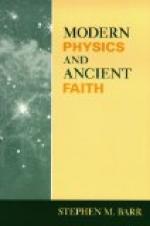The great lesson the Eastern physics burns into the pupil is that we are living not only within the prakritic earth, but within each of the other globes as well in identically the same way and subject to the same laws. Our lives are not passed on one globe, but in four globes. It is as if one said he lived in Buffalo, Erie county, New York, United States; that he was a citizen of each and subject to the laws of each.
This question of the four globes, of the four planes of matter, of the four skins, and of the four conditions or states of all matter and necessarily of all persons, from the purely material standpoint, is not only the foundation of Oriental physics, but the very essence of Oriental metaphysics—its starting-point and corner-stone. To one who carries with him, consciously or unconsciously, the concrete knowledge of the physics, the abstract teaching of the metaphysics presents no difficulty; it is as clear as crystal. But without the physical teaching the metaphysical is not translatable.
Our Western physics teaches that physical matter is divided into two kinds prakriti (commonly called “physical matter”) and ether; that the differences of each of the elementary prakritic substances (iron, copper, sulphur, oxygen) are in their molecules, the fundamental atom being the same; that each of these elementary substances vibrates only through one octave, though on different keys; that it changes from solid to liquid and gas as the rate of vibration is increased and from gas to liquid and solid as its vibration is decreased within its octave; that the ether obeys identical laws; that it has elementary substances vibrating through one octave only, and that these are solids, liquids, or gases on the etheric plane as prakriti is on this; that these etheric substances change and combine in every way that prakriti does; and that while all our prakritic substances vibrate within (say) fifty simply octaves, the lowest vibration of etheric matter begins over one thousand octaves beyond our highest, making a gulf to leap. The Eastern physics presents this with a wealth of detail that dazes the Western student, and then adds: “But beyond the etheric plane (or octave) of vibration for matter there is a third plane (or octave) of vibration called prana and beyond that a fourth called manasa. What is true of one plane is true of the other three. One law governs the four. As above so below. There is no real gulf; there is perfect continuity.”
The Western scientist teaches as the foundation of modern physics that “each and every atom of prakritic matter is the center of an etheric molecule of many atoms;” that “no two prakritic atoms touch,” although their etheric envelopes or atmospheres do touch; and that “all physical phenomena are caused by the chording vibration of the prakritic atom and its envelope of ether,” each “sounding the same note hundreds of octaves apart.” The “solid earth” with its atmosphere represents the atom with its ether. As all the oxygen and hydrogen do not combine to make the drop of water, some remaining in mechanical union to give it an atmosphere, and about one-fourth of its bulk being gas, so the atom formed of the ether does not use all the ether in its chemical union, retaining some in mechanical union for its envelope or atmosphere.




